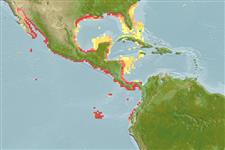Environment: milieu / climate zone / depth range / distribution range
Ökologie
seewasser riff-verbunden; tiefenbereich 3 - 30 m (Ref. 5227), usually 9 - 15 m (Ref. 5227). Tropical; 33°N - 3°S, 116°W - 77°W (Ref. 55)
Eastern Pacific: Mexico to Ecuador. Most common at offshore islands including Mapelo, Galapagos, Tres Marias and Revillagigedo.
Size / Gewicht / Alter
Maturity: Lm ? range ? - ? cm
Max length : 30.0 cm TL Männchen/unbestimmt; (Ref. 55)
Rückenflossenstacheln (insgesamt): 10; Rückenflossenweichstrahlen (insgesamt): 14-15; Afterflossenstacheln 3; Afterflossenweichstrahlen: 8. Preopercular notch and knob strong. Scale rows on back rising obliquely above lateral line. Generally bright yellow, with 5 black-edged bluish-white stripes on the sides; the belly whitish with narrow gray lines; the fins mainly yellow.
Adults are found in coastal waters, frequently around rocky and coral reefs (Ref. 9313). They occasionally occur in large schools (Ref. 9313). Also caught with nets and marketed fresh (Ref. 9313).
Life cycle and mating behavior
Geschlechtsreife | Fortpflanzung | Ablaichen | Eier | Fecundity | Larven
Allen, G.R., 1985. FAO Species Catalogue. Vol. 6. Snappers of the world. An annotated and illustrated catalogue of lutjanid species known to date. FAO Fish. Synop. 125(6):208 p. Rome: FAO. (Ref. 55)
IUCN Rote Liste Status (Ref. 130435)
Bedrohung für Menschen
Harmless
Nutzung durch Menschen
Fischereien: kleinfischerei
Mehr Information
NamenSynonymeMetabolismusRäuberÖkotoxikologieFortpflanzungGeschlechtsreifeAblaichenSpawning aggregationFecundityEierEientwicklung
ReferenzenAquakulturAquakultur ProfilZuchtlinienGenetikElectrophoresesVererbbarkeitKrankheitenVerarbeitungNutrientsMass conversion
PartnerBilderStamps, Coins Misc.LauteCiguateraGeschwindigkeitSchwimmstilKiemenoberflächeOtolithsGehirngrößeSehfähigkeit
Tools
Zusatzinformationen
Download XML
Internet Quellen
Estimates based on models
Preferred temperature (Ref.
123201): 23.2 - 28.9, mean 25.9 °C (based on 291 cells).
Phylogenetic diversity index (Ref.
82804): PD
50 = 0.5000 [Uniqueness, from 0.5 = low to 2.0 = high].
Bayesian length-weight: a=0.01479 (0.00706 - 0.03101), b=2.97 (2.81 - 3.13), in cm total length, based on LWR estimates for this Genus-body shape (Ref.
93245).
Trophic level (Ref.
69278): 4.2 ±0.74 se; based on food items.
Widerstandsfähigkeit (Ref.
120179): mittel, Verdopplung der Population dauert 1,4 - 4,4 Jahre. (Preliminary K or Fecundity.).
Fishing Vulnerability (Ref.
59153): Low vulnerability (20 of 100).
Nutrients (Ref.
124155): Calcium = 49.1 [30.1, 79.1] mg/100g; Iron = 0.42 [0.27, 0.69] mg/100g; Protein = 18.5 [16.9, 19.8] %; Omega3 = 0.136 [0.089, 0.213] g/100g; Selenium = 45 [26, 77] μg/100g; VitaminA = 277 [53, 1,126] μg/100g; Zinc = 0.454 [0.338, 0.661] mg/100g (wet weight);
